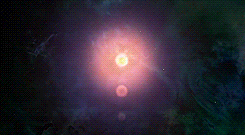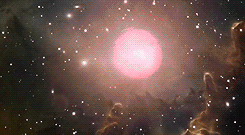 |
Today's theme: Stars
1. Stars are born inside clouds of gas and dust known as nebulae which exist throughout the galaxy. Some nebulae form from the gravitational collapse of gas in the interstellar medium while others are the result of the death throws of a massive star.
2. It might look like all the stars are out there, all by themselves, but many come in pairs. These are binary stars, where two stars orbit a common center of gravity. And there are other systems out there with 3, 4 and even more stars. Just think of the beautiful sunrises you’d experience waking up on a world with 4 stars around it.
3. The 11-year sunspot cycle is actually a part of a larger 22-year cycle in which the entire magnetic field of the Sun may reverse itself.
4. A protostar is a portion of a nebula that is about to form into a new star.
5. A nova is a sudden increase in luminosity of a star, usually in the magnitude of thousands of times its original brightness. Stars that nova usually return to their original luminosity.
6. A supernova is a stellar explosion that is more energetic than a nova. Supernovae are extremely luminous and cause a burst of radiation that often briefly outshines an entire galaxy (!!!), before fading from view over several weeks or months. During this short interval a supernova can radiate as much energy as the Sun is expected to emit over its entire life span.
7. A supernova is in about 90% of the cases significant of the death of a star. Whilst there are a few situations in which a supernova can occur without the death of a star, it is usually a sign of the last breath taken by a creator of life.
8. In about 6 billion years, the Sun’s core will run out of hydrogen. When this happens, the inert helium ash built up in the core will become unstable and collapse under its own weight. This will cause the core to heat up and get denser. The Sun will grow in size and enter the red giant phase of its evolution. The expanding Sun will consume the orbits of Mercury and Venus, and probably gobble up the Earth as well. Even if the Earth survives, the intense heat from the red sun will scorch our planet and make it completely impossible for life to survive. Finally the Sun will explode in a supernova and most likely wipe-out the whole Solar System in a fiery death.
9. The death of a star can end in one of three possible outcomes. The star becomes either a white dwarf, a neutron star or a black hole. Each of these particular cosmic object is in its own a new type as opposed to a star. Future facts will discuss each of them as they are incredibly, incredibly interesting (especially neutron stars and black holes).
10. Betelgeuse is the eighth-brightest star in the night sky and second-brightest in the constellation of Orion. The star is classified as a red supergiant (i.e. is on it's way to becoming a supernova) and is one of the largest and most luminous observable stars. If Betelgeuse were at the center of the Solar System, its surface would extend past the asteroid belt, possibly to the orbit of Jupiter and beyond, wholly engulfing Mercury, Venus, Earth and Mars. Estimates of its mass are poorly constrained, but range from 5 to 30 times that of the Sun. When it finally breathes its last, the explosion will be so bright that even though the star in the Orion constellation is 640 light-years away, it will still turn night into day and appear like there are two suns in the sky for a few weeks.
No comments
Posted at 9:52 AM | by
taoufiq












